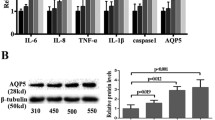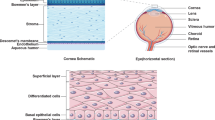Abstract
Tear film hyperosmolarity plays a core role in the development of dry eye disease (DED) by mediating the disruption of ocular surface homeostasis and triggering inflammation in ocular surface epithelium. In this study, the mechanisms involving the hyperosmolar microenvironment, glycolysis mediating metabolic reprogramming, and pyroptosis were explored clinically, in vitro, and in vivo. Data from DED clinical samples indicated that the expression of glycolysis and pyroptosis-related genes, including PKM2 and GSDMD, was significantly upregulated and that the secretion of IL-1β significantly increased. In vitro, the indirect coculture of macrophages derived from THP-1 and human corneal epithelial cells (HCECs) was used to discuss the interaction among cells. The hyperosmolar environment was found to greatly induce HCECs’ metabolic reprogramming, which may be the primary cause of the subsequent inflammation in macrophages upon the activation of the related gene and protein expression. 2-Deoxy-d-glucose (2-DG) could inhibit the glycolysis of HCECs and subsequently suppress the pyroptosis of macrophages. In vivo, 2-DG showed potential efficacy in relieving DED activity and could significantly reduce the overexpression of genes and proteins related to glycolysis and pyroptosis. In summary, our findings suggested that hyperosmolar-induced glycolytic reprogramming played an active role in promoting DED inflammation by mediating pyroptosis.
Similar content being viewed by others
References
Stapleton F, Alves M, Bunya VY, Jalbert I, Lekhanont K, Malet F, Na KS, Schaumberg D, Uchino M, Vehof J, Viso E, Vitale S, Jones L. TFOS DEWS II epidemiology report. Ocul Surf 2017; 15(3): 334–365
Farrand KF, Fridman M, Stillman IÖ, Schaumberg DA. Prevalence of diagnosed dry eye disease in the United States among adults aged 18 years and older. Am J Ophthalmol 2017; 182: 90–98
Song P, Xia W, Wang M, Chang X, Wang J, Jin S, Wang J, Wei W, Rudan I. Variations of dry eye disease prevalence by age, sex and geographic characteristics in China: a systematic review and meta-analysis. J Glob Health 2018; 8(2): 020503
Jones L, Downie LE, Korb D, Benitez-Del-Castillo JM, Dana R, Deng SX, Dong PN, Geerling G, Hida RY, Liu Y, Seo KY, Tauber J, Wakamatsu TH, Xu J, Wolffsohn JS, Craig JP. TFOS DEWS II management and therapy report. Ocul Surf 2017; 15(3): 575–628
Pflugfelder SC, de Paiva CS. The pathophysiology of dry eye disease: what we know and future directions for research. Ophthalmology 2017; 124(11): S4–S13
Dai Y, Zhang J, Xiang J, Li Y, Wu D, Xu J. Calcitriol inhibits ROS-NLRP3-IL-1β signaling axis via activation of Nrf2-antioxidant signaling in hyperosmotic stress stimulated human corneal epithelial cells. Redox Biol 2019; 21: 101093
Meng YF, Pu Q, Dai SY, Ma Q, Li X, Zhu W. Nicotinamide mononucleotide alleviates hyperosmolarity-induced IL-17a secretion and macrophage activation in corneal epithelial cells/macrophage co-culture system. J Inflamm Res 2021; 14: 479–493
Holly FJ, Lemp MA. Tear physiology and dry eyes. Surv Ophthalmol 1977; 22(2): 69–87
Jiang Y, Yang C, Zheng Y, Liu Y, Chen Y. A set of global metabolomic biomarker candidates to predict the risk of dry eye disease. Front Cell Dev Biol 2020; 8: 344
Riley MV. Glucose and oxygen utilization by the rabbit cornea. Exp Eye Res 1969; 8(2): 193–200
Rao P, Suvas S. Development of inflammatory hypoxia and prevalence of glycolytic metabolism in progressing herpes stromal keratitis lesions. J Immunol 2019; 202(2): 514–526
Chayakul V, Reim M. The enzymatic activities in the alkali-burnt rabbit cornea. Graefes Arch Clin Exp Ophthalmol 1982; 218(3): 145–148
You IC, Coursey TG, Bian F, Barbosa FL, de Paiva CS, Pflugfelder SC. Macrophage phenotype in the ocular surface of experimental murine dry eye disease. Arch Immunol Ther Exp (Warsz) 2015; 63(4): 299–304
Zhou D, Chen YT, Chen F, Gallup M, Vijmasi T, Bahrami AF, Noble LB, van Rooijen N, McNamara NA. Critical involvement of macrophage infiltration in the development of Sjögren’s syndrome-associated dry eye. Am J Pathol 2012; 181(3): 753–760
Yu L, Yu C, Dong H, Mu Y, Zhang R, Zhang Q, Liang W, Li W, Wang X, Zhang L. Recent developments about the pathogenesis of dry eye disease: based on immune inflammatory mechanisms. Front Pharmacol 2021; 12: 732887
Milner MS, Beckman KA, Luchs JI, Allen QB, Awdeh RM, Berdahl J, Boland TS, Buznego C, Gira JP, Goldberg DF, Goldman D, Goyal RK, Jackson MA, Katz J, Kim T, Majmudar PA, Malhotra RP, McDonald MB, Rajpal RK, Raviv T, Rowen S, Shamie N, Solomon JD, Stonecipher K, Tauber S, Trattler W, Walter KA, Waring GO 4th, Weinstock RJ, Wiley WF, Yeu E. Dysfunctional tear syndrome: dry eye disease and associated tear film disorders—new strategies for diagnosis and treatment. Curr Opin Ophthalmol 2017; 27(Suppl 1): 3–47
Wang S, Yuan YH, Chen NH, Wang HB. The mechanisms of NLRP3 inflammasome/pyroptosis activation and their role in Parkinson’s disease. Int Immunopharmacol 2019; 67: 458–464
Wree A, Eguchi A, McGeough MD, Pena CA, Johnson CD, Canbay A, Hoffman HM, Feldstein AE. NLRP3 inflammasome activation results in hepatocyte pyroptosis, liver inflammation, and fibrosis in mice. Hepatology 2014; 59(3): 898–910
Lorenz G, Darisipudi MN, Anders HJ. Canonical and non-canonical effects of the NLRP3 inflammasome in kidney inflammation and fibrosis. Nephrol Dial Transplant 2014; 29(1): 41–48
Kovacs SB, Miao EA. Gasdermins: effectors of pyroptosis. Trends Cell Biol 2017; 27(9): 673–684
Ji Q, Wang L, Liu J, Wu Y, Lv H, Wen Y, Shi L, Qu B, Szentmáry N. Aspergillus fumigatus-stimulated human corneal epithelial cells induce pyroptosis of THP-1 macrophages by secreting TSLP. Inflammation 2021; 44(2): 682–692
Wolffsohn JS, Arita R, Chalmers R, Djalilian A, Dogru M, Dumbleton K, Gupta PK, Karpecki P, Lazreg S, Pult H, Sullivan BD, Tomlinson A, Tong L, Villani E, Yoon KC, Jones L, Craig JP. TFOS DEWS II diagnostic methodology report. Ocul Surf 2017; 15(3): 539–574
Gao J, Morgan G, Tieu D, Schwalb TA, Luo JY, Wheeler LA, Stern ME. ICAM-1 expression predisposes ocular tissues to immune-based inflammation in dry eye patients and Sjögrens syndrome-like MRL/lpr mice. Exp Eye Res 2004; 78(4): 823–835
Ma X, Zou J, He L, Zhang Y. Dry eye management in a Sjögren’s syndrome mouse model by inhibition of p38-MAPK pathway. Diagn Pathol 2014; 9: 5
Liu Z, Chen D, Chen X, Bian F, Qin W, Gao N, Xiao Y, Li J, Pflugfelder SC, Li DQ. Trehalose induces autophagy against inflammation by activating TFEB signaling pathway in human corneal epithelial cells exposed to hyperosmotic stress. Invest Ophthalmol Vis Sci 2020; 61(10): 26
Zheng Q, Ren Y, Reinach PS, She Y, Xiao B, Hua S, Qu J, Chen W. Reactive oxygen species activated NLRP3 inflammasomes prime environment-induced murine dry eye. Exp Eye Res 2014; 125: 1–8
Dinarello CA. Immunological and inflammatory functions of the interleukin-1 family. Annu Rev Immunol 2009; 27(1): 519–550
Christofi M, Le Sommer S, Mölzer C, Klaska IP, Kuffova L, Forrester JV. Low-dose 2-deoxy glucose stabilises tolerogenic dendritic cells and generates potent in vivo immunosuppeessive effects. Cell Mol Life Sci 2021; 78(6): 2857–2876
Zhang X, M VJ, Qu Y, He X, Ou S, Bu J, Jia C, Wang J, Wu H, Liu Z, Li W. Dry eye management: targeting the ocular surface microenvironment. Int J Mol Sci 2017; 18(7): 1398
de Roetth A Jr. Glycolytic activity of the cornea. AMA Arch Opthalmol 1951; 45(2): 139–148
Thies RS, Mandel LJ. Role of glucose in corneal metabolism. Am J Physiol 1985; 249(5): C409–C416
Chen X, Rao J, Zheng Z, Yu Y, Lou S, Liu L, He Q, Wu L, Sun X. Integrated tear proteome and metabolome reveal panels of inflammatory-related molecules via key regulatory pathways in dry eye syndrome. J Proteome Res 2019; 18(5): 2321–2330
Pucino V, Certo M, Bulusu V, Cucchi D, Goldmann K, Pontarini E, Haas R, Smith J, Headland SE, Blighe K, Ruscica M, Humby F, Lewis MJ, Kamphorst JJ, Bombardieri M, Pitzalis C, Mauro C. Lactate buildup at the site of chronic inflammation promotes disease by inducing CD4+ T cell metabolic rewiring. Cell Metab 2019; 30(6): 1055–1074.e8
Hui S, Ghergurovich JM, Morscher RJ, Jang C, Teng X, Lu W, Esparza LA, Reya T, Le Zhan, Yanxiang Guo J, White E, Rabinowitz JD. Glucose feeds the TCA cycle via circulating lactate. Nature 2017; 551(7678): 115–118
Zhang JY, Zhou B, Sun RY, Ai YL, Cheng K, Li FN, Wang BR, Liu FJ, Jiang ZH, Wang WJ, Zhou D, Chen HZ, Wu Q. The metabolite α-KG induces GSDMC-dependent pyroptosis through death receptor 6-activated caspase-8. Cell Res 2021; 31(9): 980–997
Craig JP, Nichols KK, Akpek EK, Caffery B, Dua HS, Joo CK, Liu Z, Nelson JD, Nichols JJ, Tsubota K, Stapleton F. TFOS DEWS II definition and classification report. Ocul Surf 2017; 15(3): 276–283
López-Cano JJ, González-Cela-Casamayor MA, Andrés-Guerrero V, Herrero-Vanrell R, Benítez-Del-Castillo JM, Molina-Martínez IT. Combined hyperosmolarity and inflammatory conditions in stressed human corneal epithelial cells and macrophages to evaluate osmoprotective agents as potential DED treatments. Exp Eye Res 2021; 211: 108723
Chen H, Gan X, Li Y, Gu J, Liu Y, Deng Y, Wang X, Hong Y, Hu Y, Su L, Chi W. NLRP12- and NLRC4-mediated corneal epithelial pyroptosis is driven by GSDMD cleavage accompanied by IL-33 processing in dry eye. Ocul Surf 2020; 18(4): 783–794
Acknowledgements
This work was supported by the National Natural Science Foundation of China (Nos. 81870624 and 82171013) and Major Science and Technology Projects of Zhejiang Province (No. 2022C03173).
Author information
Authors and Affiliations
Corresponding author
Ethics declarations
Yu Han, Yu Zhang, Kelan Yuan, Yaying Wu, Xiuming Jin, and Xiaodan Huang declare that they have no conflict of interest. All procedures followed were in accordance with the ethical standards of the responsible committee on human experimentation (institutional and national) and with the Helsinki Declaration of 1975, as revised in 2000 (5).
Rights and permissions
About this article
Cite this article
Han, Y., Zhang, Y., Yuan, K. et al. Hyperosmolarity promotes macrophage pyroptosis by driving the glycolytic reprogramming of corneal epithelial cells in dry eye disease. Front. Med. 17, 781–795 (2023). https://doi.org/10.1007/s11684-023-0986-x
Received:
Accepted:
Published:
Issue Date:
DOI: https://doi.org/10.1007/s11684-023-0986-x




